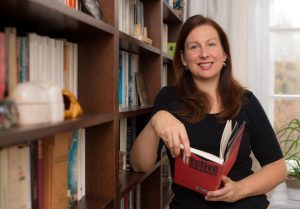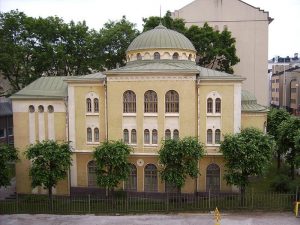
Collegium Researcher Helena Duffy
TIAS meeting, 13th January 2020. ‘What is your research project about?’ ‘What interesting thing happened to you during your recent holidays?’ These are two of the four questions to be answered during the ‘Speed Dating’ exercise. Lasting four minutes (two minutes for each person), the exercise is designed to integrate the new arrivals into the existing cohort of TIAS scholars. The people I talk to all explore questions highly pertinent to the current social and environmental crises: effects of early stress, ethics of procurement, the destruction of the primeval forest in Poland… In this context, my own ghosts of terrified and exhausted women clutching their exhausted and terrified children on the ramp at Auschwitz seem remote to the point of being unreal. But the vision continues: soldiers are barking orders in an incomprehensible language and, held on short leashes, dogs are yelping. Is it how it happened or is it how I remember it from Spielberg’s Schindler’s List? ‘I study cultural representations of Jewish mothers during the Holocaust,’ I recite in front of each new person I introduce myself to. ‘I focus on how motherhood shaped women’s experience of Nazi persecution and how the mothers’ difficult choices are judged by literature.’ Even though in Finnish the term for the Nazi genocide of the Jews is almost the same as in English, I glimpse confusion on my interlocutors’ faces when I pronounce the word ‘Holocaust’. Is it because of the noise that fills the room as some forty people are trying to talk simultaneously and we can hardly hear our own thoughts? Or is it because the Holocaust is something that ‘didn’t happen in Finland’, as the Finnish Wikipedia page ‘Holokausti’ proudly announces. So as not to jeopardise the military cooperation between Berlin and Helsinki, Heinrich Himmler gave up, at least for the moment, on pursuing Finland’s Jews. Out of the 350 Jewish refugees who had sought shelter in Finland, only eight were deported. ‘Only’ or, should I say, ‘as many as’ eight?
Coincidentally, only (or as many as?) eight students attend the course in French Holocaust literature I teach in the Department of Comparative Literature. Their learning diaries reveal both how remote the Holocaust seems to the Finns and how keen they are to know more about it. True enough, Finland has its own historical traumata: famines, a long struggle for independence, the civil war of 1918 and, in general, its precarious position between two states with imperial appetites. And yet here I am at the University of Turku, working on a Holocaust-related research project. My sense of connection as a Holocaust scholar to the place where I am conducting my research grows stronger each time I pass the seemingly disused yellowish building of the Turku Synagogue (below). Opened in 1912 and designed by August Krook and J.E. Hindersson, the synagogue sits uncomfortably tightly between two buildings. Has it always been like this or have its grounds been appropriated for other, more pressing urban projects? Sometimes, on a Saturday, lights come on inside and make me try to imagine today’s Jews of Turku. What are their histories? Do they, like many Jews around the world, originate from the Polish shtetl? What are their specific customs? Can any of them still speak Yiddish?

Turku Synagogue
A minute and a half have passed and it’s time for me to talk about my holidays, which promises to be a less sombre topic. Kraków, December 2019. I am once again in the former Jewish Quarter of Kazimierz. Originally named ‘Bawół’ [Buffalo], the area, together with two other settlements, was granted city rights and a new name by King Casimir the Great (1310-1370). The Jews of Kraków were then resettled here on the order of King Jan Olbracht, after a fire of Kraków (1494). Were they blamed for it? A few synagogues and a small Jewish cemetery have survived. Enclosed within high walls but possible to glimpse from the top floors of the neighbouring buildings, the cemetery resembles a secret garden. Names of those buried here have been eaten away by time, and yet the pebbles we pile on top of the graves testify to our will to remember those who gave this place its character and meaning. The cemetery belongs to the High Synagogue that owes its name to its unusual positioning on the first floor, above a shop. The mechitzah is on the same level as the main praying area. Why? ‘It used to be upstairs’, the caretaker points to the two blocked-off windows. Is it where my place is? There are no prayers now and we all, men and women, sit in ‘mixed pews’. An Orthodox Jew enters and begins praying. A woman with an expensive-looking camera starts photographing him with the impunity of a safari tourist taking snapshots of a grazing giraffe. Did her lens capture the man’s soul as it was trying to leave the body through shokeling? Outside, streets are teeming with tourists; they lunch in Jewish restaurants and browse in Jewish bookshops where klezmer music is playing. They buy tiny menorahs, Stars of David to wear about their necks, and controversial figurines of bearded Jews, which are supposed to bring financial luck. The Jewish Quarter without the Jews uncannily brings to mind the episode in Jonathan Littell’s 2006 novel, The Kindly Ones, where Hans Frank (Head of the German Government in wartime Poland) unravels his plans for a living museum of the soon-to-be extinct ethnic groups, including Jews. To show to future generations what these peoples were like and why they had to perish, one family from every ethnicity would be preserved. According to the novel, Frank wanted the museum to be situated in Kraków. Did he have Kazimierz in mind?
To get away from these irksome questions, I take a stroll through the circular park called ‘Planty’. There I encounter a small demonstration: armed with a portable loudspeaker, a man is inviting passers-by to sign a petition against the Justice for Uncompensated Survivors Today Act that was passed in the United States in 2017 calling for the restitution of the property of Holocaust survivors. Paradoxically, the man is dressing up his action as aimed at ‘the preservation of Polish heritage’. Suddenly (and sadly), my work appears to me more topical than ever, almost as topical as ethical procurement, consequences of early stress, or the felling of virgin forests. For some people are trying to rob the ghosts of the women standing on the ramp in Auschwitz of what they have already lost once and, even if my work cannot stop them from shouting their abusive nonsense into the loudspeaker, it can memorialise these women’s fear for what was most precious to them at that moment: their children.

Thank you Helena, this was wonderfully written text.
Thank you, Minna. I very much enjoyed writing it and I am looking forward to my next opportunity to contribute a text to our fantastic blog.
How extensive was the ancient forest that was destroyed?
Thanks